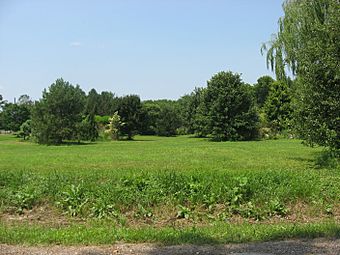Turpin site facts for kids
Quick facts for kids |
|
|
Turpin site
|
|

Overview of the site
|
|
| Location | On the Turpin farm property |
|---|---|
| Nearest city | Newtown, Ohio |
| Area | 9 acres (3.6 ha) |
| NRHP reference No. | 74001514 |
| Added to NRHP | December 27, 1974 |
The Turpin site (also known as 33Ha28) is an exciting archaeological site in Ohio, USA. It is located near Newtown in Hamilton County. This special place holds the remains of an ancient village. People from the Fort Ancient culture once lived here. The site also has several burial mounds, which are like small hills built over graves.
Archaeologists have carefully explored the Turpin site. They found the bodies of many people buried in and around these mounds. Because of its importance, the Turpin site helps experts learn about other similar ancient places. It has also been named a historic site, which means it is protected for its historical value.
Contents
Discovering the Turpin Site
People living nearby first started exploring the Turpin site a long time ago. This was at the end of the 1700s. Back then, there were at least three mounds close to the main village area. There was also an ancient Native American cemetery, which is a burial ground.
Early Digs and Finds
In the year 1800, people focused on digging in this cemetery. During this dig, they found about fifty skeletons. This showed that many people were buried there.
In 1881, the biggest mound at the site was on Philip Turpin's farm. It was known as one of the most important ancient sites in Anderson Township. This mound was about 10 feet (3.0 m) tall. Its base was about 175 feet (53 m) around. Because it was so big and near the road, it was a famous local landmark. The cemetery was densest around this large mound. An old book from 1877 said that "human remains may be exhumed with almost every lift of spade or shovel." This means they found bones very easily when digging.
More Recent Excavations
Other mounds at the site included one made of stone. Experts believe it was built during the Late Woodland period. Another mound was made of earth and dated from the Fort Ancient period. In the late 1800s, Charles Metz led digs at two smaller mounds.
The main Fort Ancient mound was explored in 1947. This dig was done by the Cincinnati Museum of Natural History. Charles Metz had noted that the Turpin family had made this mound smaller over time. More than sixty bodies were found buried inside it. Many Fort Ancient mounds had both adults and children buried in them. However, the Turpin mound had many infant bodies, which makes it special. Unlike some other Fort Ancient mounds, this one had no structures under it. Also, few bodies had grave goods, which are items buried with the dead.
Understanding the Ancient People
Professional digs in the 1900s showed that the Turpin site was mainly a Fort Ancient village. But it also had some influence from the Late Woodland people.
Fort Ancient Culture
In 1966, archaeologist James Griffin studied the Turpin site. He grouped it with the nearby Sand Ridge site. Both were part of the Madisonville Focus of the Fort Ancient culture. Twenty years later, a study looked at the timeline of the Fort Ancient culture. It placed Turpin in the Early Fort Ancient period (around 1000 to 1250 AD). The Madisonville site was from the Late Fort Ancient period.
People in Early Fort Ancient villages usually lived in single-family houses. This was different from later villages like the Madisonville site in Mariemont. There, people lived in larger houses with multiple families. The Madisonville site is just across the Little Miami River from Newtown.
Artifacts and Influences
Archaeologists found many artifacts at the Turpin site. These included decorated ceramics and a type of pottery called tempered pottery. Based on these finds, experts believe the people at Turpin were influenced by Mississippian groups. One such group was the people of the Angel phase.
A special feature of Turpin pottery is a design called guilloché. This design has holes with smaller holes in their centers. This unique design has also been found at two other sites in the Little Miami River valley. In 1986, Wesley Cowan suggested that Turpin could be a type site. This means it is a key example for a specific phase of the Fort Ancient culture in southwestern Ohio. This phase lasted from about 1000 AD to 1250 AD.
Why the Turpin Site is Important
The Turpin site is one of the most important archaeological sites in southwestern Ohio. It is used as a guide to study other Fort Ancient sites in the Ohio River area.
Studying Other Sites
In 2007, Kathleen Brady-Rawlins used a lot of information from Turpin. She used it to analyze the O.C. Voss Site in western Franklin County. She also used it for other sites in southern and central Ohio. This shows how valuable the Turpin site's discoveries are.
Protection and Recognition
The National Park Service has recognized the Turpin site as important for prehistoric preservation. It was added to the National Register of Historic Places in 1974. This means it is a protected historic place. Four other sites near Newtown, including the Madisonville site, are also on this list. The Turpin site and the farm around it are still owned by the Turpin family. They grow sod on the land today.



